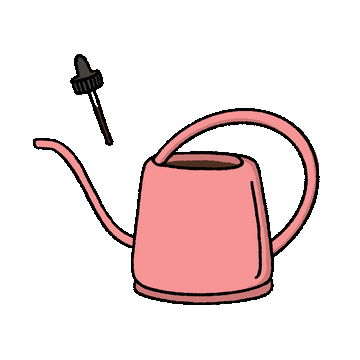Welcome to the jungle, or as we urban dwellers like to call it - our living room. Indoor gardening may be trendy, but let's be honest, our plants test our nurturing skills. Whether you're a proud member of the 'I've-never-killed-a-plant' club or you've had more plant funerals than you'd like to admit, one thing is certain - watering indoor plants is an art, not just a pour-and-forget task. So put on your imaginary gardening gloves, because we're about to hit you with the Plant Runner's Do's and Don'ts.
Do
Use a Watering Can
The quintessential gardening implement - the watering can, comes equipped with a long spout, ingeniously designed to offer precision when directing the flow of water. This allows you to deliver water right to the base of a houseplant, mitigating the risk of overwatering or water pooling on the leaves which can lead to plant diseases. On the contrary, resorting to less suitable alternatives like a drinking glass or bottle could result in an untidy mess. These vessels lack the precision of a watering can's spout, making it difficult to control the water flow, and can lead to water spilling onto the leaves or surrounding areas. This could not only damage the plants but also create a hassle for you to clean up.
That being said, in a pinch use whatever you can get your hands on - not having a watering can is no excuse for thirsty plants!
Water as required
Determining the watering needs of your houseplants involves a bit more than a casual glance - it requires a literal hands-on approach. To assess if your green companions are thirsty, gently press your finger into the potting soil, about 2-3 knuckles deep. If you find the soil to be dry to the touch, it's a clear indication that the plant is in need of hydration. However, if your finger encounters moisture just beneath the surface, it's advisable to postpone watering to avoid any risk of overhydration, which can be just as detrimental to plant health as dehydration. It's important to note that each plant is an individual with unique needs - a dry pot doesn't necessarily imply that all your plants are in immediate need of water. Make it a habit to check each plant independently, ensuring that you cater to its specific watering requirements and maintain a healthy indoor garden.
Soak the Potting Media
Too often, the problem with indoor plant care is that watering tends to be a quick and hasty affair, resulting in the plant receiving mere sips rather than a thorough soaking that it often requires. When it comes to watering your indoor plants, it's vital not to merely moisten the top layer of soil. Instead, you should water the plant deeply until you observe water beginning to seep out of the pot's drainage holes. Another, sure fire way to achieve this is through bottom watering (just make sure you don't leave the plant sitting in the water too long!)
This method of deep watering is not arbitrarily suggested; it serves a crucial purpose in encouraging the growth and development of a robust root system. By ensuring water permeates through the entirety of the potting medium, the roots are compelled to grow and extend in their pursuit of this essential resource. This results in a healthier plant that is not just thriving above the soil, but also below the surface where a complex network of roots forms its life-supporting system.
Remember, a well-hydrated plant is a happy plant. And a happy plant contributes significantly towards maintaining an indoor ecosystem that's both aesthetically pleasing and emotionally uplifting. So don't hurry through the watering process. Take your time, give your plants a good, long drink, and watch as they reward you with vibrant growth and vitality.
Water in the morning
Watering your indoor plants in the morning offers a multitude of benefits, largely due to the plant's natural growth processes and external environmental conditions. In the morning, as the sun rises and the temperature begins to increase, your plants kick-start their photosynthesis process. This process involves the use of water, absorbed through the roots, and sunlight, absorbed through the leaves, to produce glucose - their food. Watering in the morning ensures your plants have an adequate water supply to effectively carry out this crucial process throughout the day.
Another significant advantage is related to the evaporation process. Morning watering allows the excess water on the surface of the plants and the surrounding area to evaporate during the day, reducing the incidence of fungal and bacterial diseases that thrive in damp conditions. On the contrary, watering in the evening leaves your plants susceptible to these diseases as the water tends to sit on the foliage or the soil surface overnight due to reduced evaporation.
Lastly, watering in the morning aids in optimising water usage. As evenings and nights are generally cooler, the rate of water absorption by plants slows down. This means that a significant amount of the water given in the evening might never be used by the plant and only contribute to waterlogging the soil. In contrast, water supplied in the morning gets utilised more efficiently, contributing to healthy plant growth without wasting a precious resource.
Watering your indoor plants in the morning aligns with their natural growth rhythm and mitigates risks of diseases, making it a healthier and more efficient practice for your indoor gardening routine.
Water the Soil, not the foliage
Watering the soil, rather than the foliage of houseplants, is a crucial aspect of maintaining their overall health and vitality. When you water the soil, you ensure the moisture reaches the root system of the plant, where it's actually required. The roots then absorb this water and transport it to the rest of the plant. If the water is sprayed onto the foliage instead, it may not reach the roots at all. This could leave your plant dehydrated, affecting its growth and vitality.
Providing adequate moisture to the soil also supports the plant's cellular activities. Water is a key component in photosynthesis, the process by which plants create their food. It's also required for transpiration, which helps transport nutrients from the soil to different parts of the plant. When you water the soil directly, you maximise the plant's ability to carry out these important processes effectively.
Moreover, watering the foliage of houseplants, especially in low light or humid environments, can lead to fungal infections. Water droplets that sit on the leaves for extended periods can provide an ideal environment for fungal spores to germinate, leading to diseases like leaf spot or powdery mildew. These infections can harm the plant's health and are often more difficult to remedy than prevent. Therefore, by directing water to the soil rather than the foliage, you reduce the risk of fungal diseases, keeping your plants healthier and happier.
Focusing your watering efforts on the soil will ensure the plant's root system is adequately hydrated, supporting essential processes like photosynthesis and transpiration, and helping to prevent harmful fungal infections.
Don't
Let Plants sit in Water
Plants sitting in water for prolonged periods can lead to a condition known as waterlogging, which can have detrimental effects on their health and survival. When the plant's root system is submerged in water continuously, it deprives the roots of the oxygen they need to function optimally. Roots require oxygen for respiration, a process necessary for energy production and the absorption of nutrients from the soil. A lack of oxygen, as occurs in waterlogged conditions, hampers these crucial root functions, causing stress to the plant.
Further impacts of prolonged waterlogging include the onset of root rot, a serious plant disease caused by different types of fungi. These fungi thrive in overly moist conditions and begin to attack the plant's roots, causing them to decay and lose their ability to absorb water and nutrients. Symptoms of root rot include wilting, yellowing leaves, stunted growth, and eventually, the death of the plant if the condition goes untreated.
Moreover, excess water can also create an ideal environment for the breeding of pest species such as fungus gnats and mosquitos, which can further impact plant health and introduce other potential problems into your indoor garden. Therefore, it's important to avoid letting your plants sit in water and ensure proper drainage to maintain a healthy root environment, protect against disease, and deter pests.
Watering is essential for plant growth, but it's a delicate balance that requires attention and care. Over-watering and allowing plants to sit in water can lead to serious issues, from oxygen deprivation and root rot to pest infestations. To safeguard your indoor garden, make sure your plants are getting just the right amount of water, and remember, sometimes less is more.
Follow a schedule
Adhering to a strict watering schedule for indoor plants can sometimes be counter-productive. Plants, like all living beings, do not have uniform needs. These needs can change based on a multitude of factors including the type of plant, its stage of growth, the season, room temperature, and humidity levels. Watering on a rigid schedule, irrespective of these factors, could mean that your plants are frequently being over-watered or under-watered, neither of which is beneficial for their health.
For instance, some plants like cacti and succulents, which are adapted to arid environments, require less frequent watering than tropical plants, which thrive in high humidity. Similarly, the water requirements of a plant can vary with the season; they usually need more water during their growth phase in the warmer months and less during the dormant winter period.
Moreover, enforcing a strict regimen doesn't allow for adjustments based on the specific needs of your plants. Some might show signs of needing more water, like wilting leaves or dry soil, while others might exhibit symptoms of over-watering, such as yellow leaves or waterlogged soil, even if they're on the same watering schedule.
Being flexible with your watering routine and adjusting it according to the individual needs of your plants, their reactions, and the surrounding conditions is a more sensible approach. Observing your plants, understanding their unique requirements, and then responding accordingly will help them flourish.
Establishing a rough schedule can be helpful, it's important to remember that flexibility is key when it comes to watering your indoor plants. You should attune yourself to the signs your plants are giving off and adjust your watering practices accordingly, ensuring each plant's hydration needs are optimally met.
Follow the plant's label
While plant labels from nurseries can provide a basic guideline on plant care, it's essential to remember that they are often quite generic and may not offer comprehensive advice for novice plant parents. These labels typically include standard care instructions such as sunlight requirements and watering frequency, but they may not consider factors such as your home's specific conditions, humidity levels, or seasonal changes. Furthermore, these labels might not cover information regarding potential plant diseases, pests, or personalised care tips that could greatly benefit the plant's overall health. Consequently, while these labels are a good starting point, new plant owners should seek additional advice and guidance to properly cater to their plant's individual needs.
Use cold water
Using cold water to water your indoor plants can be damaging to their health, and here's why. Plants, particularly those acclimated to indoor environments, are sensitive to sudden changes in temperature. When you water them with cold water, you could shock their systems, causing a variety of detrimental effects.
The drastic change in temperature between the room environment and the cold water can disrupt the plant's normal metabolic functions, potentially slowing its growth. This is because plants often require a certain temperature range for optimal enzyme activity, which drives processes such as photosynthesis and respiration. A sudden drop in temperature could inhibit these processes, leading to a slow-down in growth, or in severe cases, stunting the plant's growth entirely.
Some plants can react negatively to cold water by showing signs of physical damage. You might notice wilting, curling, or browning of leaves after watering with cold water. These symptoms can occur because cold water can cause cell damage in the plant's foliage, impairing its ability to carry out photosynthesis, the process by which plants make their food.
Moreover, cold water can also affect the temperature of the soil, altering the living conditions for the beneficial microbes that dwell there. These soil microbes play a crucial role in nutrient recycling, helping to break down organic material into a form that plants can use. A sudden drop in soil temperature can disturb these microorganisms, possibly affecting the overall nutrient availability for your plants.
Generally best to avoid using cold water to water your indoor plants. A sudden drop in temperature can disrupt their normal functioning, cause physical damage, and alter the soil environment negatively. Instead, room temperature water is usually a safer bet, as it won't shock the plant's system and maintains a consistent environment for the plant and its associated soil-dwelling microbes.
Our dos and don'ts should hopefully serve as a comprehensive guide for plant parents. The info above underscores the importance of a flexible approach to watering, taking into account the specific needs of individual plants. With a bit of care, attention, and flexibility, your indoor garden can flourish, providing you with a lush, green environment to enjoy.



Leave a comment